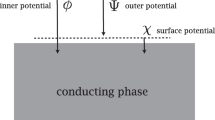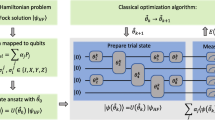Abstract
Natural orbitals (NO) and natural expansion coefficients for the ground states of the He atoms and some isoelectronic ions are calculated directly as numerical self-consistent solutions of integro-differential equations derived previously. These new applications differ from previous ones insofar as larger and more flexible sets as one-electron functions are used and as certain simplifications are no longer made. The wave functions and energies obtained here compete with the best configuration interaction results known so far and are obtained in an easier and more straightforward way. Plots of the NO's show clearly that different NO's of the same state are localized in the same region of space. Special attention is given to the problem of the convergency of the natural expansion and to the role of the correlation potential, which is defined as the difference between the effective one-electron Hamiltonians for the 1st (strongly occupied) NO and the Hartree-Fock (HF) orbital respectively. If one takes this correlation potential into account using an iterative procedure one can obtain better approximations to the first NO than the HF-orbitals are. If one is only interested in the energy it is —except for the H−-ion —irrelevant whether or not one ignores the difference between the 1st NO and the HF-orbital.
Zusammenfassung
Natürliche Orbitale (NO) und Koeffizienten der natürlichen Entwicklung für den Grundzustand des He-Atoms und einiger isoelektronischer Ionen werden direkt berechnet als numerische, selbstkonsistente Lösungen von früher abgeleiteten Integro-Differentialgleichungen. Diese neuen Rechnungen unterscheiden sich von früheren zum gleichen Problem dadurch, daß größere und flexiblere Basissätze von Einelektronenfunktionen verwendet werden und daß gewisse Vereinfachungen der Gleichungssysteme nicht mehr gemacht werden. Die hier erhaltenen Wellenfunktionen und Energien können mit den besten bisher bekannten Ergebnissen von Konfigurationswechselwirkungs-Ansätzen wetteifern, sie sind dabei in einer einfacheren und systematischeren Weise zu erhalten. Graphische Darstellungen der Radialfaktoren der NO zeigen deutlich, daß verschiedene NO's zum gleichen Zustand im gleichen räumlichen Bereich lokalisiert sind. Besondere Beachtung finden das Problem der Konvergenz der natürlichen Entwicklung sowie die Rolle des Korrelationspotentials, das als Differenz zwischen den effektiven Einelektronen-Hamilton-Operatoren für das erste (stark besetzte) NO und für das Hartree-Fock (HF-) Orbital definiert ist. Trägt man diesem Korrelationspotential in einer iterativen Weise Rechnung, so gelingt es, eine bessere Näherung für das erste NO zu erhalten als sie das entsprechende HF-Orbital darstellt. Sofern man sich nur für die Energie interessiert, so ist es — außer für das H−-Ion — unwesentlich, ob man die Verschiedenheit zwischen erstem NO und HF-Orbital berücksichtigt oder nicht.
Résumé
Les orbitales naturelles (NO) et les coéfficients du devéloppement naturel des états fondamentaux de l'atome He et de quelques ions isoéléctroniques sont calculés directement comme solutions numériques self-consistantes d'un system, derivé antérieurement, d'équations integro-differentielles. Ces calculs nouveaux different des précédents par le fait qu'on se sert maintenant de bases plus larges et plus flexibles de fonctions monoéléctroniques. En plus certaines simplifications ne sont plus faites. Les fonctions d'onde et les énergies obtenues ici sont comparables aux meilleurs resultats de calculs d'interaction de configurations connus jusqu'ici. Elles sont pourtant obtenues d'une facon plus simple et plus systématique. Les dessins des facteurs radiaux des NO demontrent que les NO appartenant au même état sont localisés dans la même région de l'espace. On s'intéresse en particulier au problème de la convergence du devéloppment naturel et au potentiel de corrélation qui est défini comme la difference des operateurs effectifs monoéléctronique pour la première NO (la NO fortement occupée) et pour l'orbitale Hartree-Fock (HF). Si l'on tient compte de ce potentiel de corrélation par un procédé iteratif on réussit à obtenir des meilleures approximations pour la première NO que celle fournie par l'orbitale HF. Pourvu qu'on ne s'intéresse qu'à l'énergie, il est — sauf pour l'ion H− — sans importance si l'on utilize l'orbitale HF ou une meilleure approximation pour la première NO.
Similar content being viewed by others
Bibliography
Ahlrichs, R., W. Kutzelnigg, and W. A. Bingel: Theoret. chim. Acta (In press).
Boys, S. F.: Proc. Roy. Soc. (London) A 201, 125 (1950); 217, 136, 235 (1953).
—: Rev. mod. Physics 32, 296 (1960).
Davidson, E. R.: J. chem. Physics 39, 875 (1963).
Davis, H. L.: J. chem. Physics 39, 1827 (1963).
Gilbert, T. L.: Rev. mod. Physics 35, 491 (1963).
Hagström, S., and H. Shull: J. chem. Physics 30, 1314 (1959).
Joy, H. W., and G. S. Handler: J. chem. Physics 42, 3047 (1965).
Kinoshita, T.: Physic. Rev. 105, 1490 (1957).
Kromhout, R. A.: Physic. Rev. 107, 215 (1957).
Kutzelnigg, W.: Theoret. chim. Acta (Berl.) 1, 327 (1963).
—: Theoret. chim. Acta (Berl.) 1, 343 (1963).
—, and V. H. Smith jr.: J. chem. Physics 41, 896 (1964).
— —: J. chem. Physics 42, 2795 (1965).
— —: Technical report 130, July 15. 1964, Quantum Chemistry Group, Uppsala, Sweden.
Lakin, W.: J. chem. Physics 43, 2954 (1965).
Löwdin, P. O.: J. math. Physics 3, 1171 (1962).
Nazaroff, G. V., and J. O. Hirschfelder: J. chem. Physics 30, 617 (1959).
Nesbet, R. K.: Adv. chem. Physics 9, 321 (1965).
—, and R. E. Watson: Physic. Rev. 110, 1073 (1958).
Nordling, J. O., and J. S. Faulkner: J. mol. Spectry.sssss 12, 171 (1964).
Pekeris, C. L.: Physic. Rev. 112, 1649 (1958); 115, 1216 (1959).
Roothaan, C. C. J.: Rev. mod. Physics 32, 179 (1960).
—, L. M. Sachs, and A. W. Weiss: Rev. mod. Physics 32, 186 (1960).
Scherr, C. W., and R. E. Knight: J. chem. Physics 40, 1777 (1964).
— —: J. chem. Physics 40, 3034 (1964).
Schwartz, C.: Physic. Rev. 126, 1015 (1962).
—: Physic. Rev. 128, 1146 (1962).
Sinanoglu, O.: Rev. mod. Physics 35, 517 (1963).
Sureau, A.: C. r. acad. Sci. 260, 1348 (1965).
Taylor, G. R., and R. G. Parr: Proc. Nat. Acad. Sci. (US) 38, 154 (1952).
Watson, E. R.: Physic. Rev. 119, 170 (1960).
Weiss, A. W.: Physic. Rev. 122, 1826 (1961).
—, and J. B. Martin: Physic. Rev. 132, 2118 (1963).
Wigner, E. P.: Physic. Rev. 46, 1002 (1934).
Author information
Authors and Affiliations
Rights and permissions
About this article
Cite this article
Ahlrichs, R., Kutzelnigg, W. & Bingel, W.A. On the solution of the quantum mechanical two-electron problem by direct calculation of the natural orbitals. Theoret. Chim. Acta 5, 289–304 (1966). https://doi.org/10.1007/BF00526135
Received:
Issue Date:
DOI: https://doi.org/10.1007/BF00526135




